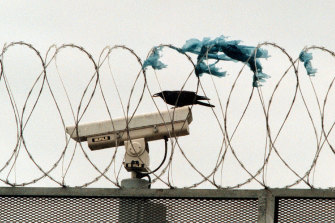Documents obtained by The Age show drones have slipped past prison defences that until recently were hobbled by a reliance on manual observation by guard patrols and CCTV to protect airspace over the sprawling complexes.
One incident report, released through freedom of information, shows authorities failed to detect a drone incursion despite the delivery apparently being made in daylight.
Until recently, Corrections Victoria relied on guards and CCTV to detect drone contraband drops.Credit:Peter Rae
“Review of CCTV footage shows a package appearing from the sky and drone within the sky. Prisoners can then be seen searching within the area, with one prisoner retrieving the package,” a report from July said.
Another smuggling run was detected weeks later, only because of a tip-off.
“Information inside was that a drone had been used to drop heroin and buprenorphine off to prisoner [redacted] about three weeks ago … It was ascertained that a drug drop had been organised for March 19. CCTV was reviewed [redacted] … Management informed,” an investigation found.
The 97 drone-related security incidents recorded from March to August include sightings, interceptions and intelligence reports about planned or suspected deliveries sourced from informers and wiretaps of inmate phone calls. Corrections Victoria has declined to comment on details of the incidents or confirm whether any contraband was seized.
The surge in drone-related activity is being attributed to COVID-19 lockdown conditions imposed across the prison system in March, which have cut off normal smuggling routes, with visits banned.
The lucrative jailhouse black market for drugs, tobacco, mobile phones and other contraband is usually supplied primarily by inmates’ relatives, friends and criminal associates who pass contraband during visits.
While the first suspected drone incursion at a Victorian prison occurred in 2014 – and it became illegal to operate one near a prison in early 2018 – until recently Corrections Victoria did not consider the threat serious enough to warrant deploying specialist anti-drone technology.
But in a bid to close the security gap exposed by the pandemic, it installed drone detection and tracking equipment for five of the state’s prisons several months ago.
Loading
The $422,000 contract for five stationary devices and one mobile unit was issued as part of the state government’s COVID-19 emergency response program. The units can track drones up to 50 kilometres away and identify the operator’s location, according to the manufacturer.
The new technology enabled guards at Barwon Prison to foil an airdrop containing drugs, a knife and a USB device in October, according to the Herald Sun. The matter is now under investigation by Victoria Police.
The stranglehold on contraband during the coronavirus lockdown has driven a 78 per cent decrease in the number of positive tests for illicit drugs among inmates, according to Corrections Victoria.
Yet tests, seizures from searches and intelligence reports show drugs such as amphetamines, ice, heroin and pharmaceutical-grade narcotics continue to enter the prison system.
“We have seen an increase in the number of attempts by prisoners to introduce contraband through the mail and over the prison walls,” a Corrections Victoria report found.
It is unclear how much contraband has been smuggled in by drones since the surge in activity began in March. The small number of incident reports obtained through freedom of information suggest authorities were unable to intercept a drone delivery until the new countermeasures were installed.
A recent interception at a NSW jail shows volumes carried by a drone can be significant, with one payload containing hundreds of opioid patches and pills worth at least $100,000.
Corrections Victoria has refused to comment on its security operations or whether the surge in drone smuggling activity can be linked to specific organised crime groups or prison gangs.
Loading
“Some people go to great lengths to smuggle drugs and other contraband into the prison system, and with prison visits suspended due to coronavirus it was expected attempts to bring in banned items would increase,” a spokesman said.
“Thanks to our new drone detection program we were able to catch this illegal activity – stopping drugs and other contraband from getting into the hands of prisoners.”
Corrections Minister Natalie Hutchins recently announced a law that would empower prison staff to substitute photocopies of incoming mail for the original pieces, which can have drugs dissolved or painted into them.
Start your day informed
Our Morning Edition newsletter is a curated guide to the most important and interesting stories, analysis and insights. Sign up here.
Chris Vedelago is an investigations reporter for The Age with a special interest in crime and justice.
Most Viewed in National
Loading
 Unmanned Aerial Vehicle The latest drone news
Unmanned Aerial Vehicle The latest drone news




